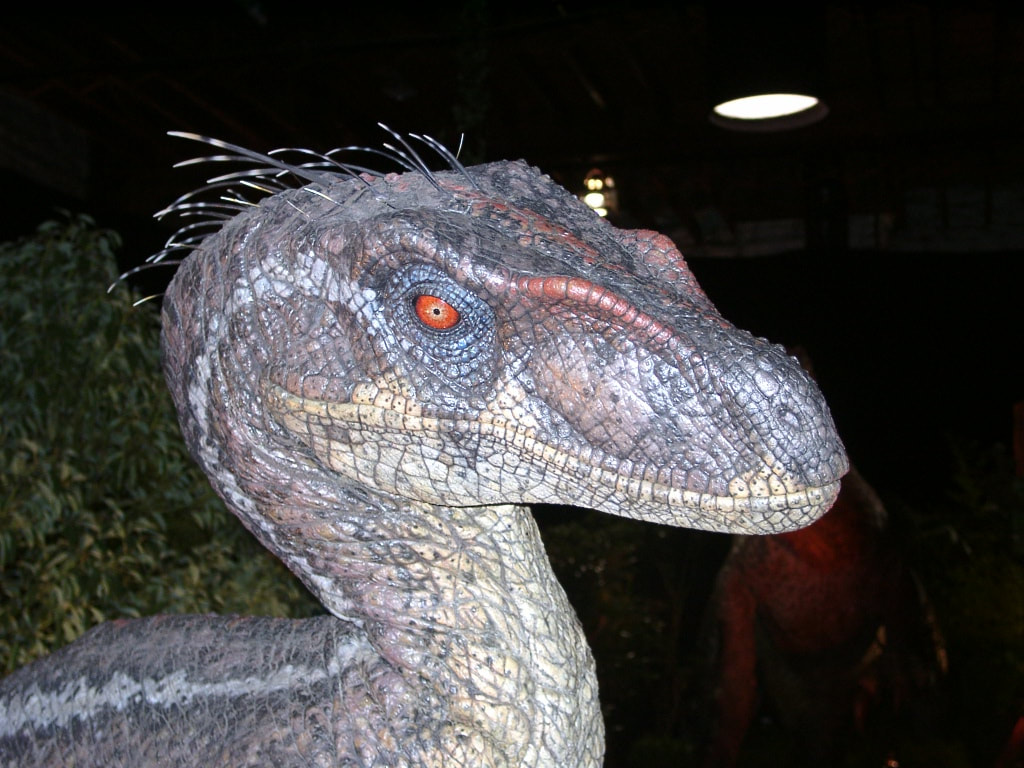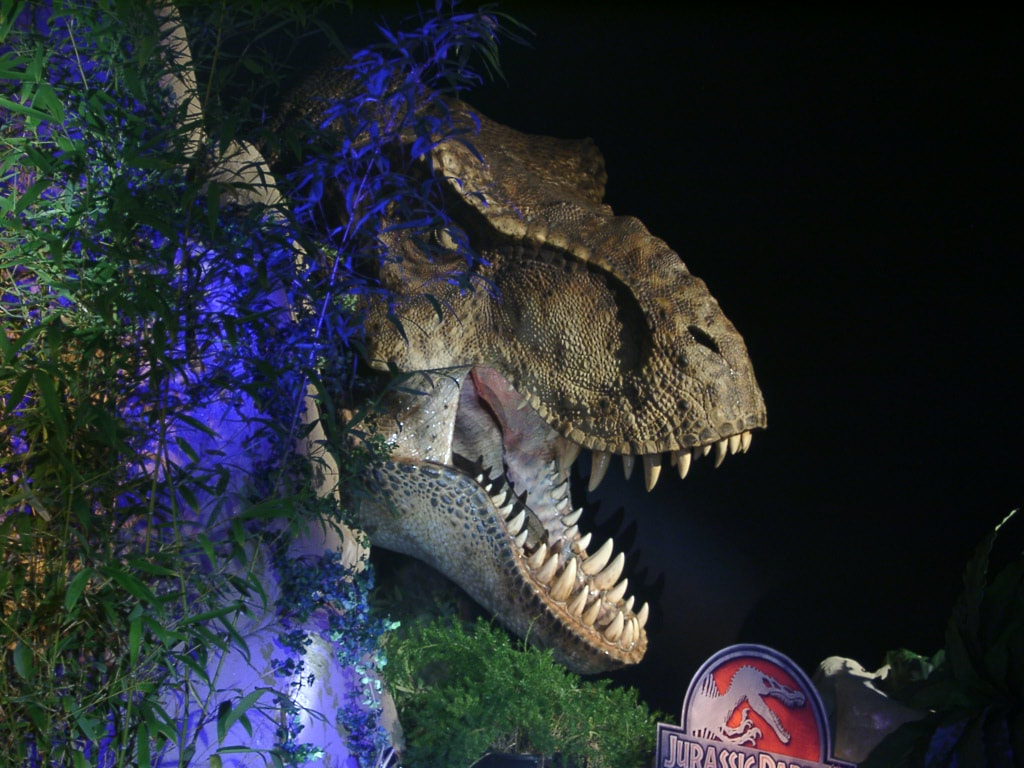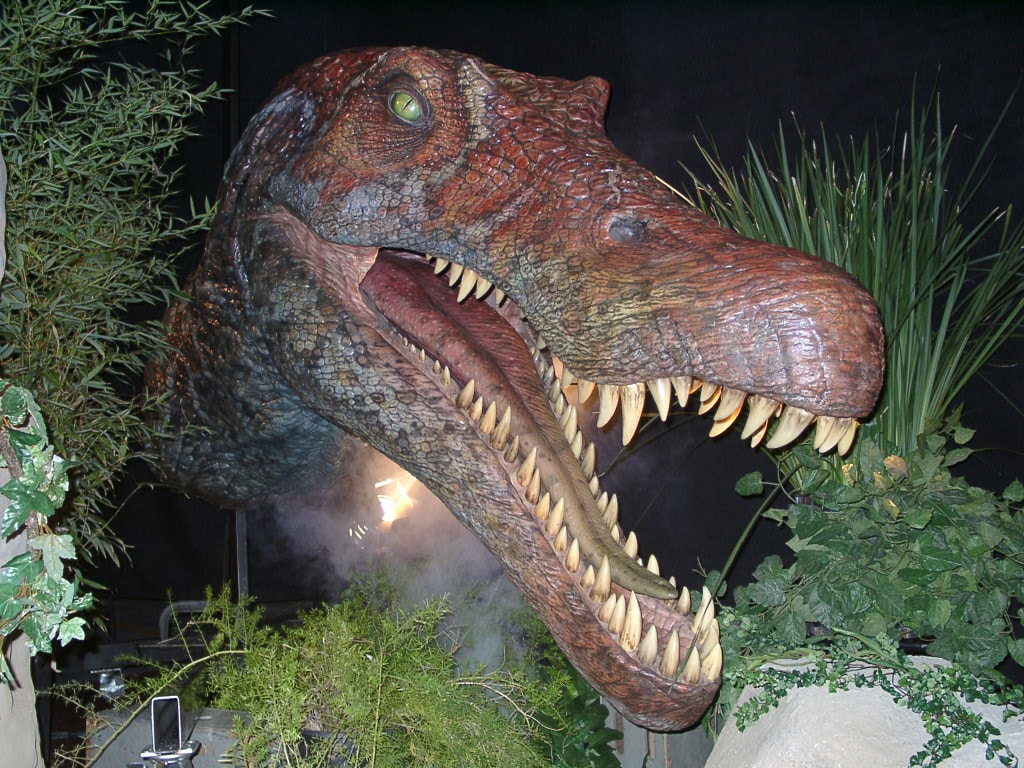|
The Jurassic Park Institute was the best source for dinosaur science resources for over six years. Millions used the web site and tens of thousands of teachers used the teaching tools the site provided. Dinosaur Earth was founded by the original content provider for the JP Institute web site and we are going to bring back some of the wonderful original materials that the site provided.
|
Changing Views of Carnivorous Dinosaurs
This story was originally published in 2002 on the JPInstitute web site as "Rethinking Theropods"
The family of dinosaurs referred to as theropods possess a number of characteristics that have defined them since Professor O.C. Marsh originally proposed the name in 1881. In the minds of tens of millions of dinosaur fans around the world these characteristics have come to define the most popular and well known dinosaurs for over a century. T. rex, Allosaurus, Velociraptor and most recently Spinosaurus have made an indelible impression on the public’s mind, the last two thanks to the Jurassic Park films. Sure, Triceratops is cool with its long, menacing horns, and Stegosaurus has those spikes on its tail that are pretty nasty. And Brontosaurus – or is it Apatosaurus – is really huge. But give the people what they want – a mouthful of serrated teeth, big, sharp claws, and cheetah-like speed. The theropods were mayhem on two legs and that’s what the public really wants in its extinct monsters.
There a plenty of specific characteristics that paleontologists can list that identify a dinosaur as a theropod. But there are a few that are readily noticeable to the average kid. All theropods walk almost exclusively on their back limbs, they have three toes pointing forward and they are carnivorous. In fact, many people simply refer to this family of dinosaurs as the meat-eaters or the carnivores. However, discoveries in the last few years have brought one of these basic defining characteristics into question. Recent evidence points to the fact that some theropods may have evolved from being carnivorous to being herbivorous – or at least omnivorous. The swift hunter stalks the Mesozoic forest, silently creeping up on its prey it pounces, powerful jaws snap shut. The vicious two-legged killer turns its head, its long, sharp claws glistening in the sun and in its mouth is the dead…fern. Not the image most people have of these primeval killers.
The way paleontologists and the general public view dinosaurs has changed dramatically over the last 20 years. Much of this is due to new discoveries and new methods of examining fossils, in addition to the revolutionary thinking of scientists such as Dr. Robert Bakker, a JP Institute advisor. Some of this change is based on the re-emergence of ideas that were proposed over a century ago. For example, in the 1870’s English scientist Thomas Huxley came to the conclusion that dinosaurs and birds were closely related and that birds likely evolved from dinosaurs. Huxley was a respected scientist as well as close friend and staunch defender of Charles Darwin. His theories were debated and accepted by a number of prominent scientists of his time. However, following his death, many ideas and facts about dinosaurs seem to have been forgotten as the science of paleontology languished through two world wars.
It was another hundred years before the idea of the bird/dinosaur relationship was resurrected, and it is now widely accepted. In the intervening time any affinity with birds was lost. The scientific view of dinosaurs became one of assigning sluggish, dim-witted characteristics to these great beasts. .
Now, another tenet of paleontology is being questioned. The discovery of oviraptorids and therizinosaurs has opened discussion as to whether some theropods went from a diet of meat to one of plants during the early and middle Cretaceous. And did those who converted share yet another trait; were they all feathered? Recent years have seen the emergence of a new, somewhat nebulous family of dinosaurs which are referred to as bird-like dinosaurs. This includes the various dromaeosaurs and oviraptorids.
In addition to the oviraptorids, the other group of feathered theropods that were likely herbivorous are the therizinosaurs. At present these strange looking dinosaurs are still an enigma, but recent discoveries are sure to help answer some questions about these strange creatures. It is unlikely that therizinosaurs evolved into any flying birds. They were quite large, with bulky bodies and had huge claws.
The majority scientific consensus is that these three theropod families all had feathers to some extent. Various paleoartists reconstructions of these dinosaurs show them in a range of having a few feathers to being nearly fully feathered. Even the huge tyrannosaurs, such as T. rex, may have had feathers as infants. It has been suggested that these giants were downy hatchlings, the down helping insulate them until they grew large enough to keep themselves warm with their bulk.
The most fascinating change in thought about theropods is not about how they looked, but rather their dining behavior. It is generally accepted – nothing in paleontology ever seems universally acknowledged – that the first dinosaurs to appear in the Triassic were carnivores. The herbivores evolved from these predators, possibly to fill the niche that was vacated by the slower, devoured non-dinosaurian prey. This development from carnivore to herbivore occurred about 230 million years ago – recent discoveries in Madagascar may push that date back another 10 million years. Until the recent discoveries, there was no evidence of any evolution from carnivore to herbivore since that time in the Triassic.
Determining exactly what it is that triggers a dietary change, and the resultant evolution of features, will occupy researchers for some time to come. The first shift from carnivore to herbivore can be easily explained – it was an environmental necessity. The early dinosaurs were most likely having an easy time of killing off the slower non-dinosaurian herbivores of the Triassic. Nature needed to find a balance.
Oviraptorids and therizinosaurs seem to have first appeared in parts of Asia. What imbalance in their early to mid-Cretaceous ecosystem caused some of them to become herbivorous? Two possibilities are a shortage of prey or an overabundance of plants. The latter is not likely, given the arid conditions of Cretaceous Asia. Perhaps the carnivores were too well designed, and so efficient at killing that prey was hard to come by.
The recent discovery of Incisivosaurus in China, an oviraptorid dinosaur that, says Dr. Philip Currie, is clearly an herbivore theropod, has caused quite a stir in an already roiling pot. Nothronychus, a North American therizinosaur, was also a plant eating theropod, says Dr. James Kirkland.
It is becoming more difficult for scientists to classify many dinosaurs as the definitions of what constitutes a specific genus or family changes with new research. Theropods, classically the favorite family for the general dinosaur fan, have undergone a great deal of change in the last two decades. The addition of feathers, the placing of some into the bird-like category and now the changing of diet has created a confusing and exciting set of circumstances for dinosaur fans and scientists. The coming years promise many new and exciting discoveries and perhaps a redefining of what constitutes a theropod.
The family of dinosaurs referred to as theropods possess a number of characteristics that have defined them since Professor O.C. Marsh originally proposed the name in 1881. In the minds of tens of millions of dinosaur fans around the world these characteristics have come to define the most popular and well known dinosaurs for over a century. T. rex, Allosaurus, Velociraptor and most recently Spinosaurus have made an indelible impression on the public’s mind, the last two thanks to the Jurassic Park films. Sure, Triceratops is cool with its long, menacing horns, and Stegosaurus has those spikes on its tail that are pretty nasty. And Brontosaurus – or is it Apatosaurus – is really huge. But give the people what they want – a mouthful of serrated teeth, big, sharp claws, and cheetah-like speed. The theropods were mayhem on two legs and that’s what the public really wants in its extinct monsters.
There a plenty of specific characteristics that paleontologists can list that identify a dinosaur as a theropod. But there are a few that are readily noticeable to the average kid. All theropods walk almost exclusively on their back limbs, they have three toes pointing forward and they are carnivorous. In fact, many people simply refer to this family of dinosaurs as the meat-eaters or the carnivores. However, discoveries in the last few years have brought one of these basic defining characteristics into question. Recent evidence points to the fact that some theropods may have evolved from being carnivorous to being herbivorous – or at least omnivorous. The swift hunter stalks the Mesozoic forest, silently creeping up on its prey it pounces, powerful jaws snap shut. The vicious two-legged killer turns its head, its long, sharp claws glistening in the sun and in its mouth is the dead…fern. Not the image most people have of these primeval killers.
The way paleontologists and the general public view dinosaurs has changed dramatically over the last 20 years. Much of this is due to new discoveries and new methods of examining fossils, in addition to the revolutionary thinking of scientists such as Dr. Robert Bakker, a JP Institute advisor. Some of this change is based on the re-emergence of ideas that were proposed over a century ago. For example, in the 1870’s English scientist Thomas Huxley came to the conclusion that dinosaurs and birds were closely related and that birds likely evolved from dinosaurs. Huxley was a respected scientist as well as close friend and staunch defender of Charles Darwin. His theories were debated and accepted by a number of prominent scientists of his time. However, following his death, many ideas and facts about dinosaurs seem to have been forgotten as the science of paleontology languished through two world wars.
It was another hundred years before the idea of the bird/dinosaur relationship was resurrected, and it is now widely accepted. In the intervening time any affinity with birds was lost. The scientific view of dinosaurs became one of assigning sluggish, dim-witted characteristics to these great beasts. .
Now, another tenet of paleontology is being questioned. The discovery of oviraptorids and therizinosaurs has opened discussion as to whether some theropods went from a diet of meat to one of plants during the early and middle Cretaceous. And did those who converted share yet another trait; were they all feathered? Recent years have seen the emergence of a new, somewhat nebulous family of dinosaurs which are referred to as bird-like dinosaurs. This includes the various dromaeosaurs and oviraptorids.
In addition to the oviraptorids, the other group of feathered theropods that were likely herbivorous are the therizinosaurs. At present these strange looking dinosaurs are still an enigma, but recent discoveries are sure to help answer some questions about these strange creatures. It is unlikely that therizinosaurs evolved into any flying birds. They were quite large, with bulky bodies and had huge claws.
The majority scientific consensus is that these three theropod families all had feathers to some extent. Various paleoartists reconstructions of these dinosaurs show them in a range of having a few feathers to being nearly fully feathered. Even the huge tyrannosaurs, such as T. rex, may have had feathers as infants. It has been suggested that these giants were downy hatchlings, the down helping insulate them until they grew large enough to keep themselves warm with their bulk.
The most fascinating change in thought about theropods is not about how they looked, but rather their dining behavior. It is generally accepted – nothing in paleontology ever seems universally acknowledged – that the first dinosaurs to appear in the Triassic were carnivores. The herbivores evolved from these predators, possibly to fill the niche that was vacated by the slower, devoured non-dinosaurian prey. This development from carnivore to herbivore occurred about 230 million years ago – recent discoveries in Madagascar may push that date back another 10 million years. Until the recent discoveries, there was no evidence of any evolution from carnivore to herbivore since that time in the Triassic.
Determining exactly what it is that triggers a dietary change, and the resultant evolution of features, will occupy researchers for some time to come. The first shift from carnivore to herbivore can be easily explained – it was an environmental necessity. The early dinosaurs were most likely having an easy time of killing off the slower non-dinosaurian herbivores of the Triassic. Nature needed to find a balance.
Oviraptorids and therizinosaurs seem to have first appeared in parts of Asia. What imbalance in their early to mid-Cretaceous ecosystem caused some of them to become herbivorous? Two possibilities are a shortage of prey or an overabundance of plants. The latter is not likely, given the arid conditions of Cretaceous Asia. Perhaps the carnivores were too well designed, and so efficient at killing that prey was hard to come by.
The recent discovery of Incisivosaurus in China, an oviraptorid dinosaur that, says Dr. Philip Currie, is clearly an herbivore theropod, has caused quite a stir in an already roiling pot. Nothronychus, a North American therizinosaur, was also a plant eating theropod, says Dr. James Kirkland.
It is becoming more difficult for scientists to classify many dinosaurs as the definitions of what constitutes a specific genus or family changes with new research. Theropods, classically the favorite family for the general dinosaur fan, have undergone a great deal of change in the last two decades. The addition of feathers, the placing of some into the bird-like category and now the changing of diet has created a confusing and exciting set of circumstances for dinosaur fans and scientists. The coming years promise many new and exciting discoveries and perhaps a redefining of what constitutes a theropod.





